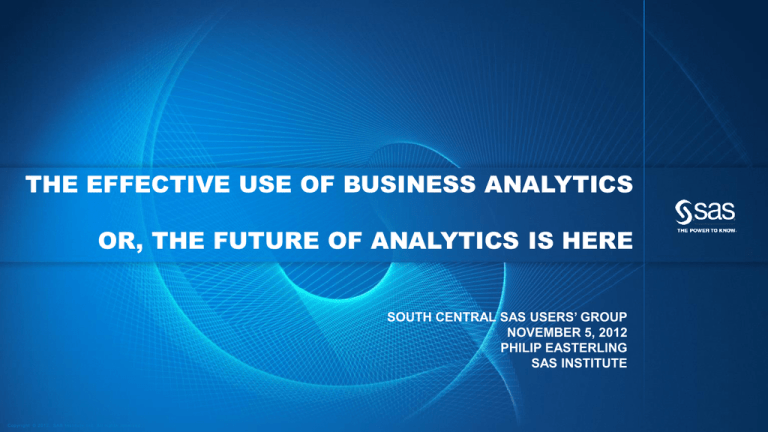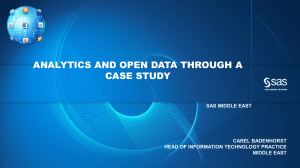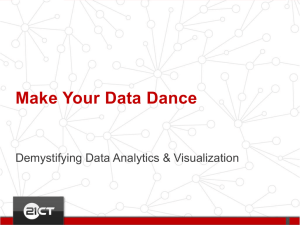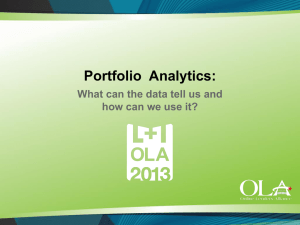
THE EFFECTIVE USE OF BUSINESS ANALYTICS
OR, THE FUTURE OF ANALYTICS IS HERE
SOUTH CENTRAL SAS USERS’ GROUP
NOVEMBER 5, 2012
PHILIP EASTERLING
SAS INSTITUTE
C op yr i g h t © 2 0 1 2 , S A S I n s t i t u t e I n c . A l l r i g h t s r es er v e d .
DISCUSSION TOPICS
Analytics versus “Business Intelligence”
Challenges to the use of Analytics
Role and Definition of Centers of Excellence
How to evaluate Analytics projects
Copyright © 2012, SAS Institute Inc. All rights reserved.
THE ANALYTICS GAP
Many organizations:
Can’t always generate the information they need.
Can’t generate insight fast enough to act upon it.
Continue to incur huge costs due to uninformed
decisions and misguided strategies.
The opportunities afforded by analytics have never been greater.
Copyright © 2012, SAS Institute Inc. All rights reserved.
WHAT IF YOU COULD …
. . . predict the buying behavior and decision criteria of your
prospects weeks before your competition?
. . . gain first-mover advantage by introducing new products and
services to micro-segments that haven't been identified by
competitors?
. . . evaluate the impact of your marketing campaigns hourly and
make adjustments in real-time?
. . . improve customer experience scores that grow products per
customer, reduce attrition, and leverage the power of customer
recommendations for new business?
. . . predict likely failures of critical equipment and processes?
Copyright © 2012, SAS Institute Inc. All rights reserved.
ANALYTICS – SAS DEFINITION
“Analytics” is probably one of the most nebulous, over-used terms in business today.
To some people, it can mean simple arithmetical calculations, such as those found in
spreadsheets and reporting queries.
“Analytics” at SAS refers to the applied mathematical capabilities of SAS software
which offer data-driven insight for better decisions.
There are different types of applied mathematics, so there is no “one size fits all”
solution to the myriad business problems which require advanced analytics.
Analytics in SAS encompass a range of techniques for collecting, analyzing, and
interpreting data in order to reveal patterns, anomalies, key variables, and relationships
( the “known unknown” and the “unknown unknown”).
Copyright © 2012, SAS Institute Inc. All rights reserved.
“ANALYTICS”
COMMON TYPES OF APPLIED MATHEMATICS IN INDUSTRY
•
Mathematical topics which analytical business consultants are unlikely to use
•
Types of applied mathematics with which analytical business consultants are likely to conduct projects
•
•
•
Types of statistical analysis and applications of statistics
•
Bayesian
•
Classical
•
Descriptive
•
Inferential
•
Predictive
•
Time series modeling
•
Quality control and process control
•
Survival analysis
Operations research and optimization
Text analytics
C op yr i g h t © 2 0 1 2 , S A S I n s t i t u t e I n c . A l l r i g h t s r es er v e d .
“ANALYTICS”
DESCRIPTIONS OF SOME TYPES OF MATHEMATICS WHICH
ARE COMMONLY APPLIED TO BUSINESS PROBLEMS
Type
Description
Simulation
Randomized repetitions of a network of discrete events in order to model real-world systems and phenomena (queues)
Optimization
Algorithm selects the best possible outcome, subject to satisfying system constraints
Matrix algebra
Calculations involving matrices solve multidimensional problems
Numerical methods
Use computers to iteratively calculate approximate solutions to calculus problems (common in engineering)
Fitting functions to data
Also called “curve fitting” by engineers
Predictive modeling
Survival analysis
Time series modeling
Fit statistical models to historical data in order to make predictions of future values
Originally used by life scientists, but adopted by marketers and actuaries
Special case when data are “auto-correlated,” such as time-dependent data (also called “Box Jenkins”)
Statistics
Classical
•
•
•
Bayesian
C op yr i g h t © 2 0 1 2 , S A S I n s t i t u t e I n c . A l l r i g h t s r es er v e d .
Descriptive: calculates metrics to characterize the distribution of values of data (mean, standard deviation, range, etc.)
Inferential: involves drawing conclusions about relationships among variables in the data (including measures of
correlation between variables)
Predictive: involves studying historical data in order to make accurate predictions of future outcomes
Used to augment classical analysis when there is prior knowledge about how the data was generated
ANALYTICS – EXAMPLE APPLICATIONS
TEXT ANALYTICS
Finding treasures in unstructured data
like social media or survey tools
which could uncover insights
about consumer sentiment
FORECASTING
Leveraging historical time series
data to provide better insights into
decision-making about the future
INFORMATION
MANAGEMENT
OPTIMIZATION
Analyze massive
amounts of data in
order to accurately
identify decisions
which are likely to
produce the most
optimal results
DATA MINING
Mine transaction databases
of records about spending
patterns which indicate a
stolen card
STATISTICS
Copyright © 2012, SAS Institute Inc. All rights reserved.
THE IMPACT OF ANALYTICS SPANS THE ENTIRE ORGANIZATION
Trusted, analytically-based decisions are needed across the organization.
Successful analytics are
necessary in every business
discipline: Planning, Research
and Development, Marketing,
Sales, Operations, Finance,
Manufacturing, and Information
Technology.
Copyright © 2012, SAS Institute Inc. All rights reserved.
ANALYTICS PRESENT CHALLENGES THAT OTHER TECHNOLOGY
PROJECTS INITIATIVES DO NOT
The processes of building solutions and answering complex business questions are
often less "linear," requiring much exploratory analysis and modeling in a somewhat
iterative process
Even "canned" applications and toolsets may require special skills to implement and
to use effectively
Advanced skills in statistics, econometrics, operations research, and/or computer
science, and the expertise on their application to business problems, are often a
constraint
Data from outside the organization may be needed (e.g., business partner,
macroeconomic, demographic, survey, weather, government, trade association, etc.)
C op yr i g h t © 2 0 1 2 , S A S I n s t i t u t e I n c . A l l r i g h t s r es er v e d .
THE ANALYTICS LIFECYCLE
BUSINESS
MANAGER
Domain Expert
Makes Decisions
Evaluates Processes and ROI
EVALUATE /
MONITOR
RESULTS
IDENTIFY /
FORMULATE
PROBLEM
DATA
PREPARATION
DEPLOY
MODEL
IT / SYSTEMS
MANAGEMENT
Model Validation
Model Deployment
Model Monitoring
Data Preparation
BUSINESS
ANALYST
Data Exploration
Data Visualization
Report Creation
DATA
EXPLORATION
DATA MINER /
STATISTICIAN
VALIDATE
MODEL
TRANSFORM
& SELECT
BUILD
MODEL
Copyright © 2012, SAS Institute Inc. All rights reserved.
Exploratory Analysis
Descriptive Segmentation
Predictive Modeling
CURRENT
TRENDS IN
ANALYTICS
Copyright © 2012, SAS Institute Inc. All rights reserved.
12
CURRENT TRENDS
IN ANALYTICS
Complex Business Problems Drive Analytics Innovation
•
Ongoing research to ensure that analysts have access to modern techniques
which are robust and scalable
•
Innovative computational implementations of existing analytical methods
•
Creative applications of existing methods to solve new and different problems
•
Integration of methods from multiple disciplines to provide targeted solutions
Copyright © 2012, SAS Institute Inc. All rights reserved.
CURRENT
TRENDS IN
ANALYTICS
THE GROWING GAP IN AVAILABLE ANALYTICS TALENT
IS DRIVING THE DEMOCRATIZATION OF ANALYTICS
Copyright © 2012, SAS Institute Inc. All rights reserved.
CURRENT
TRENDS IN
ANALYTICS
THE GROWING GAP IN AVAILABLE ANALYTICS TALENT
IS DRIVING THE DEMOCRATIZATION OF ANALYTICS
The demand for deep analytical talent in the United States could be 50 to 60 percent greater than its projected supply by 2018.
THOUSAND PEOPLE
SUPPLY AND DEMAND OF DEEP ANALYTICAL TALENT BY 2018
30
180
440 - 490
300
50 - 60% gap
relative to
2018 supply
150
2008
employment
140 - 190
Graduates with
deep analytical
talent
Others 1
2018 supply
Talent gap
2018 projected
demand
1 Other supply drivers include attrition (-), immigration (+), and re-employing previously unemployed deep analytical talent (+).
SOURCE: US Bureau of Labor Statistics; US Census; Dun & Bradstreet; company interviews; McKinsey Global Institute analysis
Copyright © 2012, SAS Institute Inc. All rights reserved.
CURRENT
TRENDS IN
ANALYTICS
LEVERAGE ANALYTICS TO UNLOCK
THE INFORMATION CONTAINED IN
UNSTRUCTURED DATA
Copyright © 2012, SAS Institute Inc. All rights reserved.
16
CURRENT TRENDS IN ANALYTICS - BIG DATA
DATA SIZE
VOLUME
VARIETY
VELOCITY
VALUE
TODAY
THE FUTURE
Copyright © 2012, SAS Institute Inc. All rights reserved.
CURRENT TRENDS
IN ANALYTICS
“Big Data” is RELATIVE, not ABSOLUTE
Big Data (Noun)
When the volume, velocity, and variety of data exceeds an
organization’s storage or computing capacity for accurate
and timely decision-making
Copyright © 2012, SAS Institute Inc. All rights reserved.
CURRENT TRENDS
IN ANALYTICS
The Changing Information Technology Environment
•
•
•
Open Source
•
Hadoop
•
R
Infrastructure Technologies
•
Cloud Computing
•
Grid
•
In-Database
•
In-Memory
•
Mobile Devices
Information Management
•
Stream It, Score It, Store It
Copyright © 2012, SAS Institute Inc. All rights reserved.
Copyright © 2012, SAS Institute Inc. All rights reserved.
CHALLENGES
TO THE USE
OF ANALYTICS
Copyright © 2012, SAS Institute Inc. All rights reserved.
21
EXTERNAL
VIEWPOINT
CHALLENGES IN ANALYTICS ADOPTION
Source: The Current State of Business Analytics: Where Do We Go From Here?
Prepared by Bloomberg Businessweek Research Services, 2011
Copyright © 2012, SAS Institute Inc. All rights reserved.
COMMON OBSERVATION
AND REQUIREMENTS
Information Challenges
•
Growth in external data, such as from social media sources
•
Complexity, access, and security
•
Data availability, quality, consistency, and format
•
Alignment with changing business requirements
•
Human resources, such as Analytical, Domain, IT Staff, etc.
•
Enterprise architecture, master data management (MDM), and governance
•
Infrastructure scalability, reliability, and cost
Copyright © 2012, SAS Institute Inc. All rights reserved.
COMMON OBSERVATION
AND REQUIREMENTS
Organizational Challenges
•
“We invested so much in technology and other resources”
•
“The business return is not directly visible or quantifiable”
•
“We have difficulties in balancing operational, tactical, and strategic priorities”
•
“We lack a 360°view of our customers”
•
“We have too many repetitive processes”
•
“We have different competing priorities”
•
“We need to strengthen our competitive advantage”
Copyright © 2012, SAS Institute Inc. All rights reserved.
Information for
Overcoming Challenges
SAS Research and Publications
Organizational Assessment
and Alignment
Initial Framework for
Centers of Excellence
Copyright © 2012, SAS Institute Inc. All rights reserved.
Business Analytics for
Decision Making
Organizational
Dimensions
Key to Alignment
Business Analytics Skills and Resources
• Analytical, technical, and interpersonal skills
• Training and career advancement to attract and retain talent
Information Environment and Infrastructure
• Relevant, accurate, consistent, and timely enterprise information
• Mature and capable enterprise information infrastructure
Internal Processes
• Well-defined set of processes to identify, rank, and address analytical requirements
• Coordinate support from IT, analytical resources, and computing power
Organizational Culture
• Understand, value, and demand fact-based decisions strategies
• Communicate the value of analytics, fund staffing, and reward proper use
Copyright © 2012, SAS Institute Inc. All rights reserved.
Organizational
Dimensions
THE JOURNEY TOWARD THE TARGET
Change from a “Project” to a ”Program” mentality
Change from a “Tactical” to a “Strategic” approach
Provide business and IT with shared ownership of
the enterprise information environment
“Enterprise centers of excellence should support the effort …”
Copyright © 2012, SAS Institute Inc. All rights reserved.
Organizational
Dimensions
THE JOURNEY TOWARD THE TARGET
An executive vision and commitment to demand an
information-driven organization and culture
Focus upon key organizational dimensions
Human capital
Internal information processes
Technical infrastructure
Organizational culture
Continual alignment with business objectives
Supported by an enterprise analytics Center of Excellence
Copyright © 2012, SAS Institute Inc. All rights reserved.
THE ROLE AND DEFINITION OF
CENTERS OF EXCELLENCE
Copyright © 2012, SAS Institute Inc. All rights reserved.
29
What is a Business Analytics Center of Excellence?
An internal strategic team of analytics experts …..
with a specific mission to facilitate and promote the
use of analytics …..
to achieve business objectives across the enterprise.
It can be its own department, a virtual department, or
a combination of both.
Copyright © 2012, SAS Institute Inc. All rights reserved.
CENTERS OF EXCELLENCE CHARACTERISTICS
Sponsored by the executive team
Includes IT, business domain expertise, and analytic expertise
Has a well defined charter, responsibilities, and processes
Collaborates with ALL appropriate stakeholders
Strives to make analytics a repeatable and accessible process
Emphasizes the implementation of successful analytic applications
Copyright © 2012, SAS Institute Inc. All rights reserved.
A Center of Excellence will enable the organization to:
• Develop and evolve the Business Analytics infrastructure
• Promote collaboration and leading practices
• Achieve better results (growth, cost reduction, profitability,
service effectiveness, quality improvement, etc.)
Copyright © 2012, SAS Institute Inc. All rights reserved.
EVALUATING
ANALYTICAL
PROJECTS
Copyright © 2012, SAS Institute Inc. All rights reserved.
33
Evaluating Analytic Projects
Assessment
Gap Analysis
Recommendation
and
Development
Copyright © 2012, SAS Institute Inc. All rights reserved.
Ongoing
Support
Analytic Approach and Methodology
Assessment
Understand the vision,
business objectives, and
priorities of the executive
team
Assess the current
environment and
capabilities, including
infrastructure, people,
process, and culture, using
the information evolution
model
Optional: Benchmark
current information maturity
against competitors
Recommendation
and
Development
Gap Analysis
Analyze desired
capabilities versus
current capabilities
Conduct a gap analysis
between desired and
current capabilities in
each of the four
organizational
dimensions
Ongoing
Support
Identify starting points
Develop detailed
recommendations,
initiatives, and a
roadmap to achieve the
desired capabilities
Support business unit
in the implementation
and operation phase
Monitor and make
adjustments if
necessary
Provide enterprise
best practices and
lessons learned
Identify potential
analytics Center of
Excellence role
Develop Center of
Excellence details
Copyright © 2012, SAS Institute Inc. All rights reserved.
SOME GUIDING
PRINCIPLES
•
•
•
•
•
•
Evaluating Analytical Projects
Choose projects with high business priorities
Potential outcomes should produce business value
Define success up front and how to measure it
Have the skills and resources to use analytics
Have integrated and consistent data available
Have enough historical data
Copyright © 2012, SAS Institute Inc. All rights reserved.
Fact-based decision making
requires the right technology,
talent, processes, and culture.
TECHNOLOGY
FACT-BASED
CULTURE
BUSINESS
PROCESS
PEOPLE
Copyright © 2012, SAS Institute Inc. All rights reserved.
REVIEW OF DISCUSSION TOPICS
Analytics versus “Business Intelligence”
Challenges to the use of Analytics
Role and Definition of Centers of Excellence
How to evaluate Analytics projects
Copyright © 2012, SAS Institute Inc. All rights reserved.
QUESTIONS? THANK YOU FOR ATTENDING
THE EFFECTIVE USE OF BUSINESS ANALYTICS
SOUTH CENTRAL SAS USERS’ GROUP
NOVEMBER 5, 2012
PHILIP.EASTERLING@SAS.COM
WWW.SAS.COM
C op yr i g h t © 2 0 1 2 , S A S I n s t i t u t e I n c . A l l r i g h t s r es er v e d .









